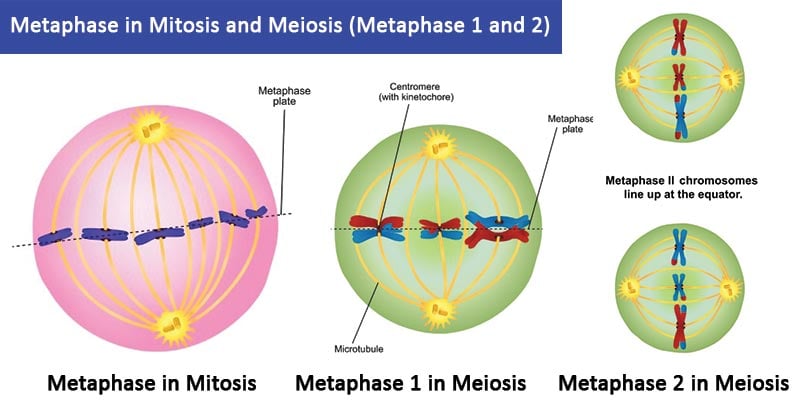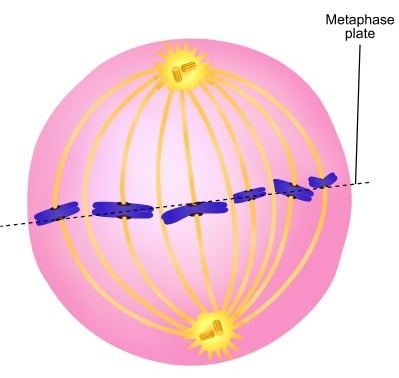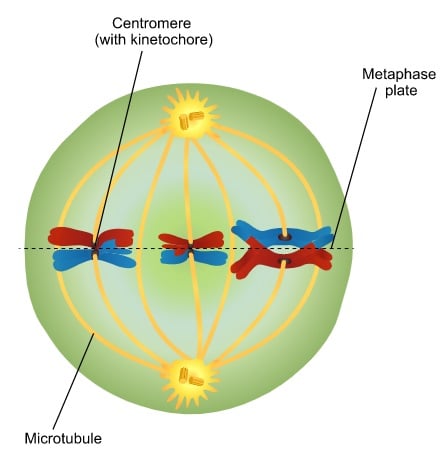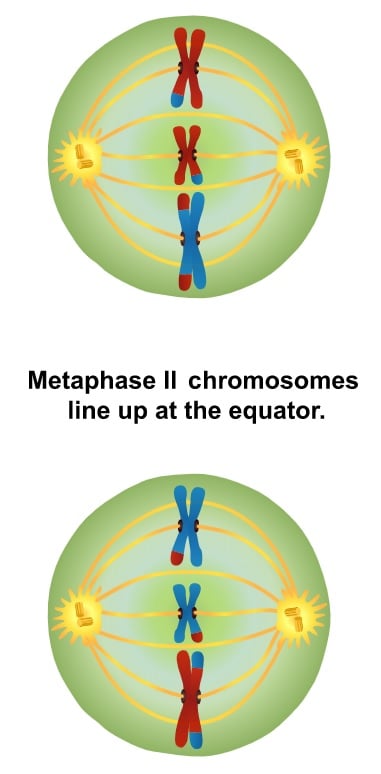Interesting Science Videos
Metaphase Definition
Metaphase is a stage of the cell cycle occurring in both mitosis and meiosis cell division processes. During metaphase in mitosis and meiosis, the chromosomes condense and they become visible and distinguishable during alignment at the center of the dividing cell, to form a metaphase plate at the center of the cell.
In this phase, a series of checkpoints take place ensuring the spindles are formed. In karyotyping studies, the metaphase stage is used to detect chromosomal abnormalities.

Image Source: Ali Zifan (Wikipedia) and Ali Zifan (Wikipedia).
What happens in metaphase?
- Metaphase involves the separation of the duplicated genetic material that is carried in the nucleus of the parent cells, to form two identical daughter cells.
- The process in metaphase involves the alignment of the chromosomes at the center of the cell by pulling and pushing, and what others would tern as a cellular tug of war.
- The replicated chromosomes remain joined at the centromere as sister chromatids.
- Before metaphase, the prophase stage formed radial microtubules known as kinetochores around the centrosome.
- The kinetochores are attached by long protein filament microtubules (kinetochore microtubules) that extend from the poles on either end of the cell.
- The kinetochore tubules pull the sister chromatids back and forth (tug of war) until an alignment at the equator of the cell is achieved. This forms an equatorial plane.
- Additionally, a metaphase checkpoint also takes place during metaphase.
- The metaphase checkpoint that is known as the spindle assembly checkpoint, ensures that the cell is ready to divide by checking the alignment of the chromosomes and the correct attachment of the kinetochores.
- However the differences between mitosis and meiosis in the chromosome alignment, the spindle assembly checkpoint must take place during metaphase in both types of cell cycles.
- When these processes are correct, then the cell enters the fourth phase of mitosis known as the anaphase.
Metaphase of Mitosis

Figure: Metaphase of Mitosis. Image Source: Ali Zifan (Wikipedia).
- Metaphase is a subsequent phase in the cell division cycle that follows up from the condensation of the chromosomes from prophase.
- The condensation process is important to ensure that the chromosomes (chromatids) do not get damaged during the pulling and pushing forces they undergo in metaphase.
- At the end of prophase or prometaphase, It is noted that the chromosomes are randomly arranged within the cell nucleus, within a dissolved nuclear membrane.
- However, the polar and the radial microtubules are connected to each of the chromosomes.
- During mitosis, the microtubules from each of the centrosomes connect to each chromosome, which is made up of two identical sister chromatids. The sister chromatids are connected by proteins known as cohesins.
- The presence of microtubules allows the cell to be a dynamic element in that they apply the forces of pulling and pushing.
- This is accomplished by the kinetochore microtubules, allowing the sister chromatids to get aligned at the center of the cell forming a metaphase plate.
- The subunit of these microtubules known as tubulin is added and removed constantly from the ends of the microtubules. This causes a treadmilling form of movement of the microtubules and the sister chromatids.
- These treadmilling forces also contribute to the tight holding of the sister chromatids.
- The alignment of the chromatids along the metaphase plate ensures that the new cells that will be formed will be identical.
- The chromatids must be attached to the microtubules from both poles of the cell and aligned at the metaphase plate for the spindle assembly checkpoint to take place.
- The checkpoint prolongs the period of metaphase, which can take days to ensure the chromosomes are properly aligned.
- After the checkpoint, the chromosomes release a signal activating the anaphase-promoting complex which leads to the end of metaphase and the beginning of anaphase.
Metaphase of Mitosis Video Animation
Metaphase of Meiosis
Metaphase I in Meiosis
- During meiosis I the cells involved are analogous, in that a diploid cell divides into haploid (half of the chromosomes).
- It works by involving chromosomal crossing over genes creating genetic diversity in the daughter cells of the next generation from the parent cells.
- DNA replication that takes place before meiosis forms the sister chromatids and therefore, during the meiosis I, the process starts with a homologous pair of each chromosome.
- The homologous pair is a representation of the same DNA but has different alleles.
- The homologous pairs will attach to each other during metaphase I and they undergo the alignment on the metaphase plate, unlike in mitosis where the sister chromatids are the ones that align on the metaphase plate.
- During this phase, a spindle checkpoint takes place, otherwise known as the meiotic spindle checkpoint.
- This checkpoint ensures that the homologous pairs and each pair is attached to the kinetochore microtubules from each side of the cell before proceeding to the next phase which is anaphase I.
- Successful metaphase I ensure that meiosis I continue creating two cells each with two copies of half of a full genome.

Figure: Metaphase 1 in Meiosis. Image Source: Ali Zifan (Wikipedia).
Metaphase I in Meiosis Video Animation
Metaphase II in Meiosis
- This is the second phase of meiosis II.
- This is the phase where the two daughter cells produced during the first meiotic division, have their meiotic spindles start to draw the chromosomes to the metaphase plate, again.
- This is to prepare the centrosome for division in the next phase.
- It takes place after a short break known as interkinesis.
- This initiates the cells to start dividing again, without any DNA replication taking place. Therefore, each cell will have two copies of one allele for each gene.
- Additionally, the nuclear envelope breaks down as metaphase II begins
- However, in this stage, the two kinetochores of each centromere will bind to the spindle fibers from the opposite poles.
- This leads to a separation of the sister chromatids of each chromosome in the next phase.
- Also, a meiotic spindle checkpoint takes place during the separation of the chromatids for a swift move to the next phase.

Figure: Metaphase 2 in Meiosis. Image Source: Ali Zifan (Wikipedia).
Applications of Metaphase
- During the metaphase stage of cell division, is when genetic abnormalities can be detected by karyotyping.
- This is because cross overs (meiosis) take place during this phase and the pulling and pushing of the chromatids by the kinetochore microtubules may cause damages to the chromosomes if the mitotic spindle checkpoint and the meiotic spindle checkpoint are missed.
References and Sources
- https://www.sparknotes.com/biology/cellreproduction/mitosis/section2/
- https://www.britannica.com/science/metaphase
- https://www.sciencedirect.com/topics/biochemistry-genetics-and-molecular-biology/metaphase
- https://www.genome.gov/genetics-glossary/Metaphase
- https://www.nature.com/scitable/definition/metaphase-249/
- https://www.nature.com/scitable/topicpage/mitosis-and-cell-division-205/
- http://www.phschool.com/science/biology_place/biocoach/meiosis/metai.html#:~:text=The%20centrioles%20are%20at%20opposite,poles%20called%20the%20metaphase%20plate.
- https://www.sciencedirect.com/science/article/abs/pii/S0074769601120073
- https://www.biologyonline.com/dictionary/metaphase-ii
- http://cyberbridge.mcb.harvard.edu/mitosis_6.html
- http://cyberbridge.mcb.harvard.edu/mitosis_7.html
- http://www.macroevolution.net/metaphase-ii.html


